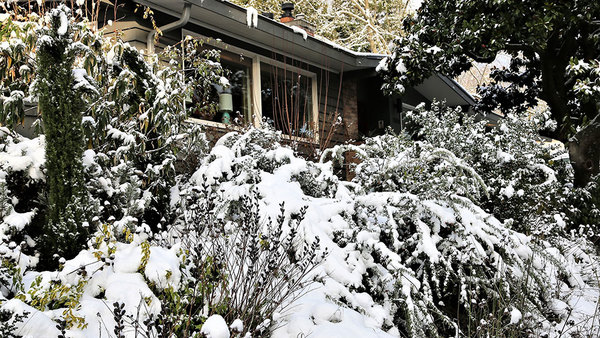
February brings uncertain weather and tests a gardener’s patience. It can feel like the Longest. Month. Ever. But stay strong. The changes in the length of days will begin to be noticeable—to you and to your plants. Take advantage of the thaws, and when the weather turns Arctic again, attend to your indoor garden.

Clean and sharpen tools. Arborists say the best time to prune trees and shrubs is when your tools are sharp. So start your winter pruning projects with a cutting tool tune-up. Clean sap and dirt off tools with detergent and a kitchen scrubby before sharpening cutting edges with a whetstone or diamond dust sharpener. Follow the beveled angle, and make sure all bypass surfaces are smooth and burr-free before reassembly. Replace parts and tools that are beyond repair. Lastly, work a drop of household oil into the parts of each tool.

Prune trees and shrubs. The next-best time to prune most tree and shrub species is while they’re dormant. (Exceptions: Wait to prune early spring-flowering trees and shrubs until right after they bloom, and maples (Acer spp. and cvs., Zones 3–9) after full leaf-out.) Remove suckers and dead and diseased limbs, and prune for shape and airflow. Save sturdy twigs and thin branches to use as props or pea stakes for top-heavy plants like peonies (Paeonia spp. and cvs., Zones 3–8), dahlias (Dahlia spp. and cvs., Zones 7–10), and cosmos (Cosmos spp. and cvs., Zones 9–11).

Force branches into flowering. If you need to prune spring-flowering shrubs and trees for shape—and even if you don’t—bring some branches inside to force into early bloom. Before arranging in vases, give your stems a fresh cut plus a vertical slice up the center of the stem to expose more pith to water. Place stems in warm water, and change the water daily to speed flowering. Stems may take a week to a month or more before blooming depending on the species and the length of time before natural flowering. The best branches to force include those of forsythia (Forsythia spp. and cvs., Zones 5–8), winter honeysuckle (Lonicera fragrantissima, Zones 4–8), flowering quince (Chaenomeles spp. and cvs., Zones 5–9), flowering dogwood (Cornus florida, Zones 5–9), magnolia (Magnolia spp. and cvs., Zones 3–9), and fruit trees.

Pay attention to houseplants. It doesn’t take much of a change in the sun’s angle for houseplants to get growing. Stay a step ahead. Prune overgrowth, remove dead leaves, and treat infestations by hosing insects down the drain or spraying with a mild soap solution or horticultural oil. (Always do a test first to check for foliar sensitivity.) They will need watering more frequently now too. Transplant root-bound plants into larger containers with fresh potting soil. Always dampen potting soil prior to potting.

Organize your seed storage. It’s too early to start seeds (except for sweet peas (Lathyrus odoratus, Zones 2–11), cardoon (Cynara cardunculus, Zones 7–9), and artichoke and others that need extra time and cool temperatures). Instead, channel that energy into organization. Create a spreadsheet with target sowing dates, or simply group seed packets together with rubber bands based on sowing time. Go through your saved seeds. Keep what you want, and give the rest away.
If only Groundhog’s Day weren’t followed by six more weeks of winter! But it’s easier to see the light at the end of the tunnel when we take advantage of the best days outside and inside to prepare for spring.
—Kristin Green is author of Plantiful: Start Small, Grow Big With 150 Plants That Spread, Self-Sow, and Overwinter. She gardens in Bristol, Rhode Island.


















Comments
Log in or create an account to post a comment.
Sign up Log in